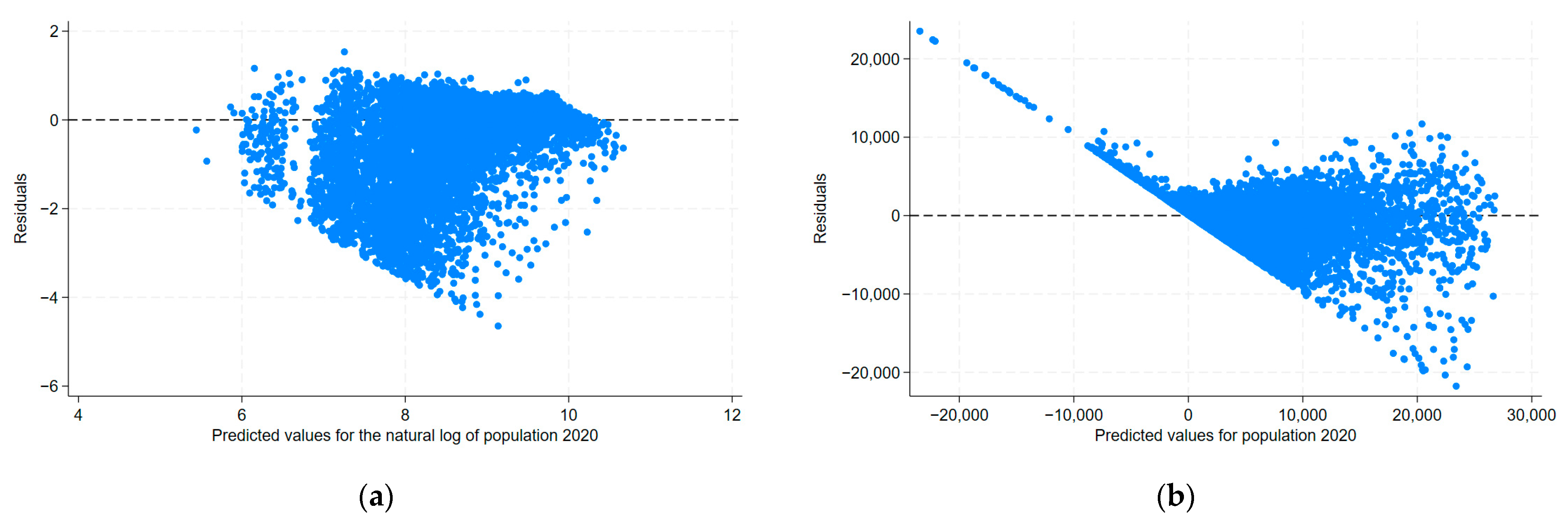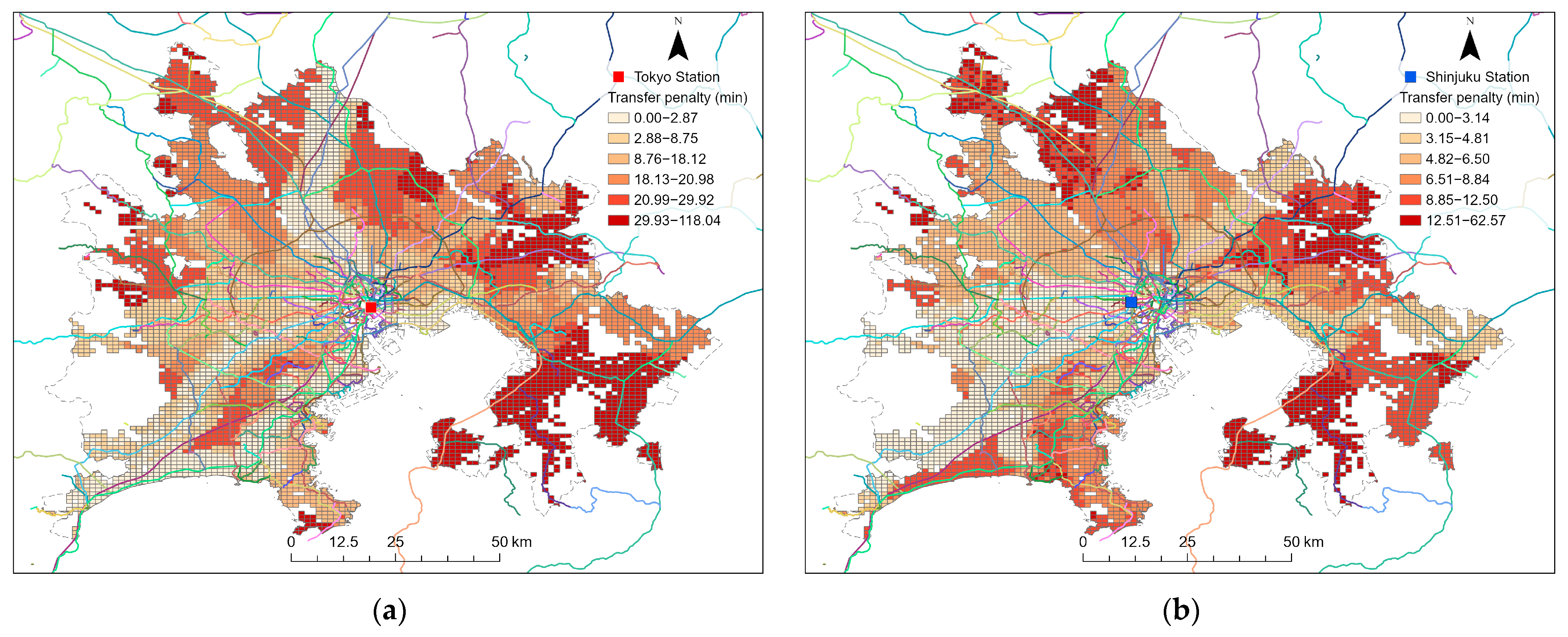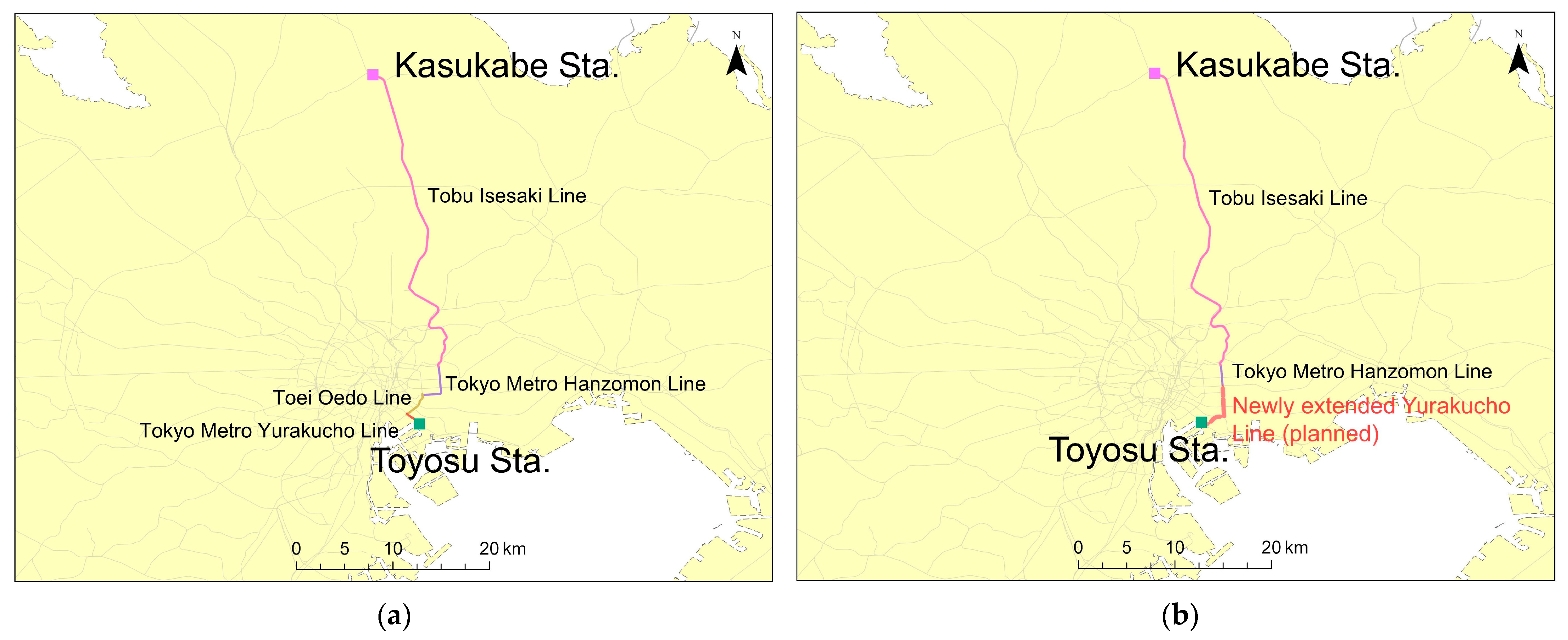2.2. Study Area
This study focuses on the Tokyo Metropolitan Area in 2020, the largest metropolitan region in Japan and one that is highly dependent on rail transportation. In particular, within the 23 special wards of Tokyo—the city’s central core—railways account for approximately 50% of all trips [
13]. Given this high reliance on rail transport, the influence of railway accessibility and transfer penalties on daily mobility is substantial, making the Tokyo Metropolitan Area a suitable case for analysis. In addition, compared to major cities worldwide, Tokyo’s 23 wards have the second-highest station and rail line density after Paris, surpassing cities such as New York, Seoul, London, and Singapore [
14]. In cities with such high railway density, rail usage is typically high; however, transfer penalties are likely to have a particularly significant impact on travel behavior.
There are multiple definitions of the Tokyo Metropolitan Area; in this study, I adopted the Urban Employment Area definition proposed by [
15]. Unlike administrative boundaries, this definition is based on functional linkages shaped by socio-economic activity. Specifically, it defines a metropolitan area as comprising a central city—identified by densely inhabited districts (DIDs)—and surrounding municipalities with a commuting rate of 10% or higher to the central city.
In this study, I used the Tokyo Metropolitan Employment Area as the spatial scope of analysis. I used the list of cities included in the Tokyo Metropolitan Employment Area as defined by [
16] to determine the spatial boundaries of the study area.
Figure 1 presents the study area, including railway lines and population distribution at the 1 km grid level. Tokyo Station is designated as the destination point for calculating accessibility and transfer penalties. Located in the Marunouchi district—Tokyo’s business center—Tokyo Station is widely recognized as a major transportation hub in the metropolitan region [
17].
To focus the analysis on accessibility from suburban and sub-center areas to the city’s core, I excluded Chiyoda Ward, Minato Ward, and Chuo Ward—three wards located in the city center—from the analysis. The remaining area encompasses approximately 130 railway lines operated by 40 different railway companies.
2.3. Variables and Estimation Model
Mesh-level accessibility and transfer penalties were calculated using a network dataset comprising mesh center points, railway stations, railway lines, and Tokyo Station. The origin of each trip was defined as the center point of each mesh, with Tokyo Station set as the destination. Travel time to Tokyo Station via the railway network was calculated and used as a measure of accessibility for each mesh.
To quantify the transfer penalty, the waiting time corresponding to each railway station was predicted based on the train frequency data. The transfer penalty for a mesh was then defined as the difference in travel time to Tokyo Station with and without this transfer-related waiting time.
Figure 2 illustrates the conceptual framework used for calculating travel time and transfer penalties.
The specific method for calculating mesh-level accessibility and transfer penalties was explained using the notation presented in
Figure 2. As the index of accessibility, the travel time from grid
o to Tokyo Station without transfer penalty was calculated as follows:
where
refers to the waiting time for the first train station
,
is the Euclidean distance from the center of grid
o to the first railway station on a route,
is the length of the rail line
from the origin station to the destination station,
is the walking distance for transfers for the transfer
(
kth transfer), and
is the distance from the destination station to Tokyo Station. If transfers are possible at the same station,
becomes zero. If it is possible to reach Tokyo Station directly by railway,
becomes zero.
and
are the assumed speeds for walking and railway, respectively. In addition, if the travel distance to the first station
exceeds 1 km, it is assumed that the distance beyond 1 km will be traveled by other means of transportation (e.g., bus, car, motorcycle, etc.) since it is not realistic to travel such a long distance on foot. In this case, the travel speed for the additional distance is set to 30 km/h.
In addition, the travel time with a transfer penalty was assumed to be as follows:
where
is the waiting time for the next train for a transfer
at station
. This means that for the
kth transfer at the station
, it will take
for the next train. In this analysis, I assumed that
is 4 km/h and
is 80 km/h, respectively, based on previous studies [
18]. For this analysis, travel times are calculated in minutes.
In addition, I predicted
based on the data of the frequency of trains for each railway station obtained from [
19]. Train intervals are inversely proportional to train frequency. Assuming that passenger arrivals at stations are random, the average waiting time for a train is half the interval between trains. Consequently, the average waiting time is also inversely proportional to train frequency. Based on this logic, the average waiting time at each station was calculated using the following formula:
where
represents the average waiting time at station
s, and
denotes the train frequency at station
s. The constant
a is predicted using observed data from example stations. I selected Sasazuka Station, which has the highest train frequency in the dataset, and Shimo-Itabashi Station, which has the median frequency among stations in the target area. Sasazuka Station operates up to 387 trains per day, corresponding to an average waiting time of approximately 2 min during rush hours. Shimo-Itabashi Station operates up to 157 trains per day, with an average waiting time of about 5 min during rush hours. Based on these values, I set
a = 779 for calculating waiting times across all stations. As a result, the median estimated waiting time was 4.96 min, and the minimum was 2.01 min.
To calculate the shortest routes, I used ArcGIS Pro to perform a network analysis. The network was constructed using the centers of each mesh, all railway stations, and Tokyo Station (the final destination) as nodes, with railway lines serving as edges. Additionally, several necessary supplementary edges were added: (1) Mesh-to-station connections—edges were created between the center of each mesh and all railway stations within a 5 km radius, representing access from the mesh to nearby railway stations. (2) Final destination connections—edges were created between all railway stations within 1 km of Tokyo Station, representing the final walking segment from a nearby station to Tokyo Station itself. (3) Transfer connections—edges were created between all railway stations located within 1 km of each other to account for transfers between closely situated stations.
Using this network, I determined the shortest route from each mesh to Tokyo Station. Travel time, as defined in Equations (1) and (2), was used as the cost function for route selection. The shortest travel time computed using Equation (1), which does not account for transfer waiting times, was denoted as
. On the other hand, the shortest travel time using Equation (2), which assumes a waiting time for each transfer, was denoted as
. The transfer penalty was then calculated as follows:
It is important to note that the shortest route without transfer waiting time and the shortest route with transfer waiting time are not necessarily the same. Under the assumption of Equation (2), an additional waiting time was added for each transfer compared to Equation (1). For example, consider two routes: Route A requires one transfer and takes 20 min without considering transfer waiting time, and Route B does not require any transfer and takes 25 min. If transfer waiting time is not considered, Route A is the shortest, and . However, if each transfer adds a 10 min penalty, the travel time for Route A becomes 30 min, making Route B the shortest, and . In this case, the transfer penalty is .
The impact of the absolute value of penalty time depends on the length of the original travel time. Therefore, in addition to the penalty in minutes, I calculated the rate of the increase in travel time due to the transfer as follows:
Using the indices calculated above, I estimated the following OLS model to clarify the impact of accessibility and transfer penalties on current and future population distribution:
where
is the number of populations living in mesh
o, and
is a city fixed effect. In Equation (6),
and
represent the effects of a 1% increase in travel time to Tokyo Station and a 1% increase in transfer penalty on the number of passengers, respectively.
represents the university graduation rate for the town in which mesh
o is located. This variable is included to control for the socio-demographic characteristics of the area, in place of income level, which is not available at the fine spatial resolution. Data on university graduation rates for the year 2020 were obtained from the Population Census of Japan (
https://www.e-stat.go.jp/statistics/00200521, accessed on 14 March 2025).
I also estimated the following model:
Compared to Equation (6), Equation (7) aims at estimating the effects of the ratio of transfer penalty to travel time on the population distribution. Additionally, to examine the impact on future population distribution, I also estimated a model that uses the projected population for 2030 and 2070 as supplementary dependent variables in addition to the current population (2020). Across all specifications, standard errors were clustered at the city level.
Table 1 shows the summary statistics of the variables.














